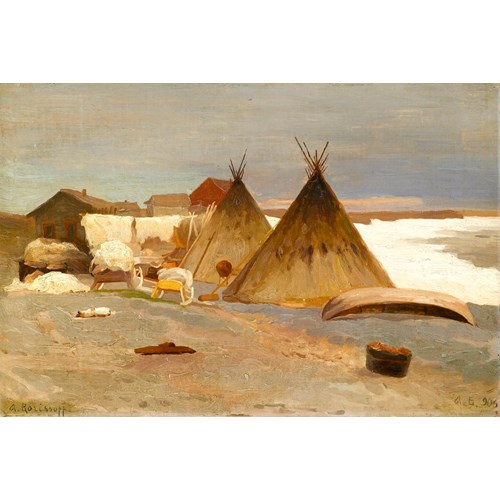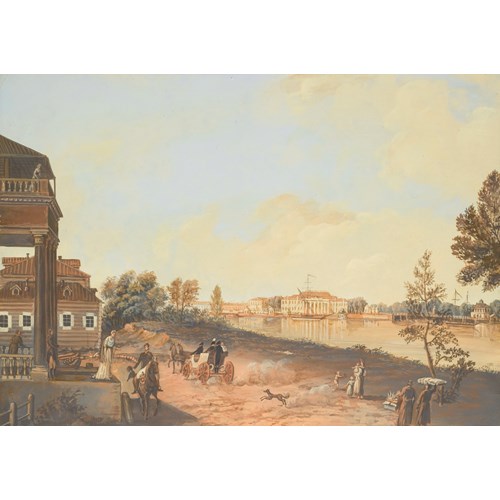Johann Georg Paul Fischer
Russian Uralsk & Don Cossacks on the Attack
Date 1806/14
Epoque 1750-1850, 19th century
Origine Germany, England
Medium Pen, Grey ink, Watercolour, Pencil on paper, Bodycolour
Dimension 20.5 x 29 cm (8¹/₈ x 11³/₈ inches)
A date of 1806 appears on the mount of Russian Uralsk & Don Cossacks on the Attack, which would place the scene during the War of the Fourth Coalition (1806-1807). Although this was a highpoint for the French armies in the Napoleonic Wars, the Cossacks are today regarded as a major factor in the eventual repulsion of Napoleon’s invasion of Russia. In fact, Napoleon himself is reputed to have said: ‘Cossacks are the best light troops among all that exist. If I had them in my army, I would go through all the world with them.’
The watercolour was part of a series of twelve by Johann Georg Paul Fischer, which depicted armies involved in the Napoleonic Wars. These watercolours, a larger set of which hang in the Royal Collection, drew to some extent on the stereotypes of those depicted in them. The Russian soldiers are assigned menacing and sinister faces, which is very much in keeping with how the Cossacks were seen by the rest of Europe. Unlike other army formations, the Cossacks were not paid and instead their service was a form of feudal reciprocation. Accordingly, the Cossacks could loot and pillage wherever they went, and so became known as savage and wild soldiers.
In contrast, Fischer’s watercolour in the same series, The 92nd Regiment of Foot or The Gordon Highlanders, (1814, Private Collection) shows a significantly more organised scene, displaying the greater discipline of the British army. There are distinct similarities in the foreground of both images, where the foliage and shrubbery are clearly by the same hand. In both works Fischer has plainly focused on depicting the differing appearance and character of these national types. The original mounts identify the variety of figures in each watercolour, so that in the present work the viewer can compare the Uralsk and Don Cossack. Similarly in The 92nd Regiment of Foot or The Gordon Highlanders, Fischer depicts the difference in rank and regiment, as a sergeant stands next to a colonel, and an officer of the Royal Scots Greys is conspicuous on the right-hand side. A comparison between the works highlights the national characteristics of the figures. Whereas the Cossacks are shown as wild and savage, the British troops are composed and immaculately dressed. The Cossacks are engaged in an impromptu guerrilla attack, whilst the Gordon Highlanders are shown as a more formal and organised force, reflecting the different natures of the armies.
Fischer was the son of an engraver and pupil of German portraitist Johann Heinrich Ramberg (1763-1840) to whom he was apprenticed and whom he assisted in his portrait work. He worked as court painter and restorer to the Duke of Bavaria, and ‘modernised’ old master works, most notably and controversially, Albrecht Dürer’s (1471-1528) Paumgartner family altarpiece (now in the Alte Pinakothek, Munich).
He came to England in 1810, working mainly in London, and executed portraits of the English aristocracy, including Queen Charlotte (1738-1820) and Queen Victoria (1819-1901). He is now most well-known for his portrait miniatures but his watercolours are also highly regarded.
Date: 1806/14
Epoque: 1750-1850, 19th century
Origine: Germany, England
Medium: Pen, Grey ink, Watercolour, Pencil on paper, Bodycolour
Signature: Signed, inscribed and dated ‘J. Paul Fischer fit. /London 1814’ (lower left);
further inscribed with title and dated 1806, on the original wash-line mount.
Dimension: 20.5 x 29 cm (8¹/₈ x 11³/₈ inches)
Plus d'œuvres d'art de la Galerie









